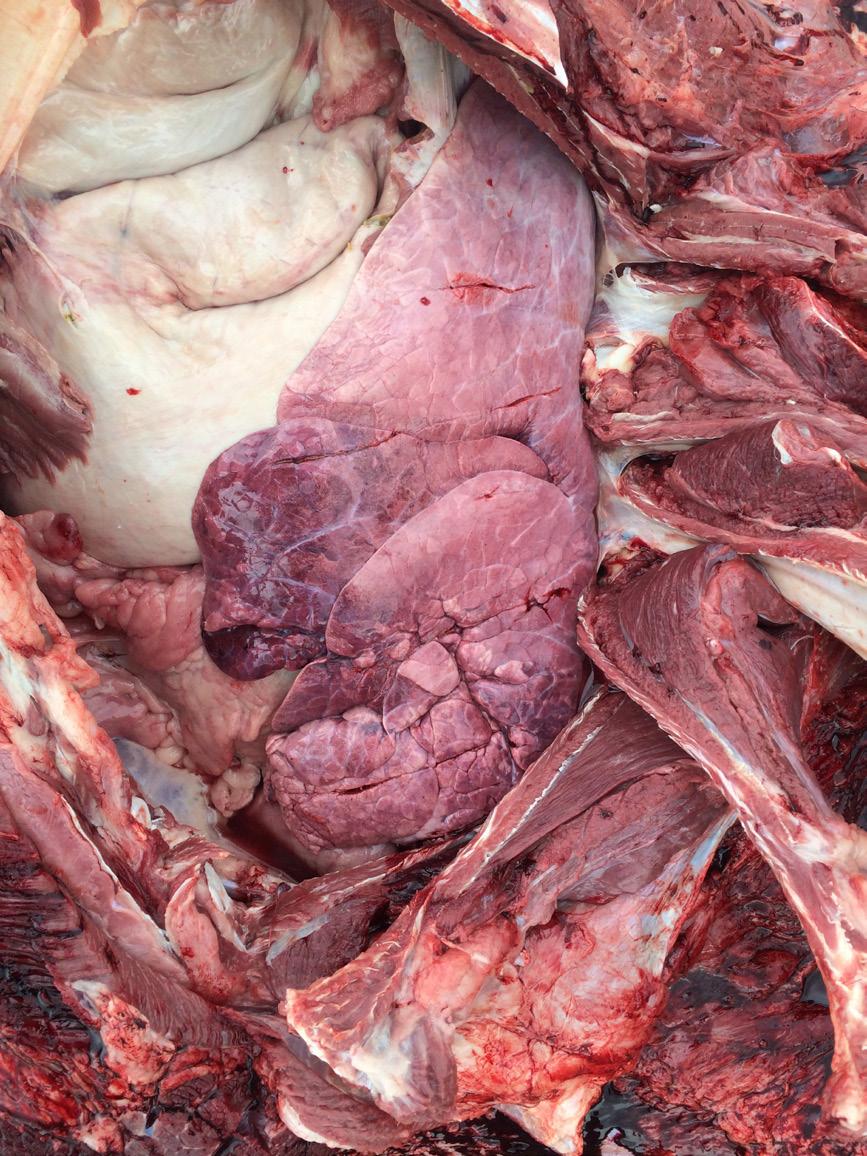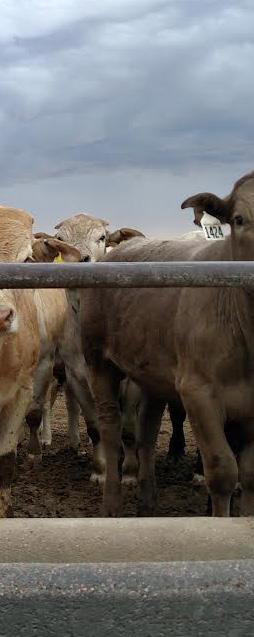
4 minute read
Clinical Case Review: Bloat in Feedlot Cattle

By: Dr. Dan Thomson, Production Animal Consultation
Rumen tympany, commonly known as bloat, is a frustrating disease in feedlot cattle. Bloat is characterized by extension of the rumen by either free gas or rumen contents due to froth accumulation. Many times, bloated cattle are found dead due to the acute nature of this disease. While we manage pens of cattle and intakes, acidosis and bloat are individual animal illnesses similar to respiratory disease or lameness.
There are two types of bloat syndromes in cattle: frothy bloat and free gas bloat. Frothy bloat occurs most commonly in cattle that are consuming wheat pasture or legumes such as alfalfa. Free gas bloat occurs most frequently as a sequela to acidosis in feedlot cattle. Feedlot cattle over-consume grain concentrates which leads to a rapid decrease in rumen pH. The drop in rumen pH and increased acid load in the rumen due to rapid fermentation of soluble carbohydrate can decrease rumen contractions and prevent eructation. Without eructation, the cattle cannot relieve their rumen gas build up from the fermentation process. As rumen fermentation proceeds, the gases cause distention of the rumen and bloat is diagnosed (figure 1).
There are three main categories of causes for cattle bloat: ration composition, human error and weather. All cattle are different and will react differently to changes in their daily feed consumption based on weather, ration or people causes.

In general, the higher the percentage of concentrate and the more processed the concentrate source, the higher the likelihood for acidosis and bloat in feedlot cattle. Also, consistency of the fat source in the diet needs to be maintained to not cause a disruption in feed intake or rumen function.
Abrupt switches of high quality to low quality fat sources, or vice versa, can cause bloat issues in feeder cattle. Bunk reading, feed calls and determination of when to change rations can be risk factors associated with bloat due to human error (figure 2).
The severity of the bloats in cattle can be graded 0 through 3.
Bloat score 0 = Cattle are not distended in the paralumbar fossa area.
Bloat score 1 = Cattle are mildly distended (puffy) on the left side of their body.
Bloat score 2 = Cattle are severely distended on the left side of their body but not on the right side (papple shaped).
Bloat score 3 = Cattle are distended on both the right and left side of their body.
Cattle that have bloat scores of 3 tend to have stunted growth the rest of their life based on wheat pasture research at the TAMU Vernon, TX research station.
Cattle that die of bloat have collapsed lungs and anterior carcass congestion and reddening (figure 3). Hind quarters are pale with edema located between muscle groups.
Treatment of bloat is straight forward. Determination of free gas or frothy bloat can be determined by passing an oral gastric tube into the rumen. Free gas bloats will immediately begin to go down as the tube enters the cardia region of the rumen. Frothy bloat will have froth regurgitate up the oral gastric tube.
We treat frothy bloat with poloxalene (trade name Therabloat) oil. The oil breaks up the surface tension of the froth in the rumen. In the free gas bloat, we let the gas escape and place the calf on a hospital ration with increased hay access.

The general rule is that we will let a calf down up to three times. At the third free gas bloat treatment, this animal should be considered a chronic bloat. These animals should be sold to salvage slaughter or we should put a fistula in the left paralumbar fossa that allows gas to escape continuously through the external hole.
Lastly, weather, season of the year and population of the cattle are probably the most common cause of bloat. Spring is the bloat season in feedlots. During the spring, the feedlots are full of cattle that are at peak consumption of feed. We also have increased day length which stimulates a spring “pop” in intake of usually one pound per head per day across the entire feedlot.
Spring winds and showers will tend to send cattle to the back corners of the pen to ball up as a group. When the wind lays down in the evening, the cattle are hungry. They then charge the bunk and over-consume. This can lead to acidosis and bloat.
A lesser cause of free gas bloat can be cattle laying down in a position that they cannot get up, otherwise termed overbalance. Overbalance cattle have their feet uphill and cannot stand up due to pen maintenance or mound maintenance. When laying on their side, the gas cap in the rumen moves from the cardia region to the side and the calf cannot eructate causing bloat due to expansion of the gas cap.
If you have an emergency bloat case, do not let the animal lay down. A severely bloated calf that lays down will suffocate and die quickly. A caregiver should use a bloat needle or knife to stick the calf on the apex of the bloated left side of the animal to relieve the gas pressure.
Bloat prevention is not easy when increased performance and improved feed efficiency are necessary for profitability. Working with your nutritionist on ration balancing, grain processing, feed mixing and feed delivery are extremely important.
Also, consult with your nutritionist on the use of non-nutritive feed additives such as ionophores that might modulate feed intake and control bloat issues.
Preventing chronic respiratory disease might also prevent some bloat cases by decreasing cattle with vagus nerve damage (“vagal” calf). Watch weather patterns and realize the population of cattle you have at the yard as both will be indicators for risk of bloat.

On wheat pasture, the number one risk factor for frothy bloat is the amount of fertilizer applied to the pasture causing a lush growth of wheat and providing more substrate for a similar number of calves. Poloxalene blocks, ionophores and other treatments can help prevent cattle from bloating on wheat pasture.










